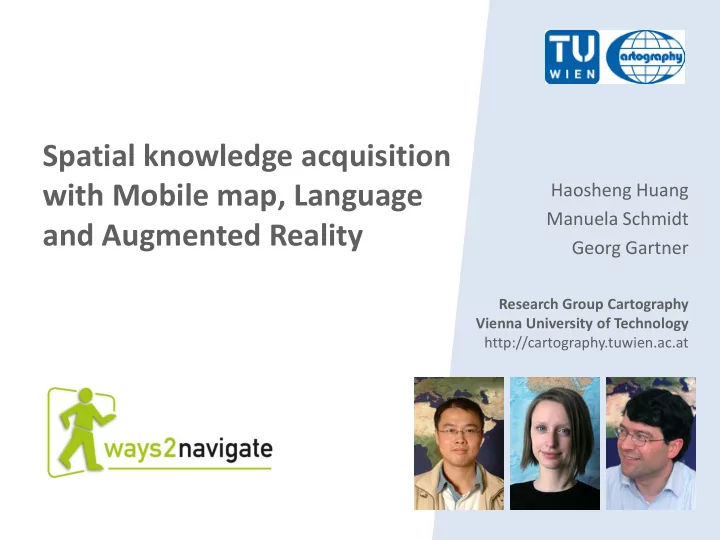

Spatial knowledge acquisition with Mobile map, Language Haosheng Huang Manuela Schmidt and Augmented Reality Georg Gartner Research Group Cartography Vienna University of Technology http://cartography.tuwien.ac.at
Background Ways2navigate project … … investigating the suitability of mobile map, language, and Augmented Reality (AR) for communicating route information to pedestrians Three iterative field tests … … how these technologies can help to reduce congitive load during wayfinding … how these technologies influence the acquisition of spatial knowledge 2/18
Spatial Knowledge Acquisition Spatial knowledge … … essential for wayfinding and other spatial tasks The effect of navigation systems on spatial knowledge acquisition … … people would get lost when navigation systems fail 3/18
Research Goal Empirically studying the differences in spatial knowledge acquisition … … with different presentation forms: mobile map, language and AR … in the context of GPS-based pedestrian navigation … in an urban environment 4/18
Methodology: Test Route 5/18
Methodology: Test Persons 24 test persons … … 13 female, 11 male, age range 22-63 yrs (mean: 40) … divided into three groups … within subject design (72 person/sub-route pairs) 6/18
Methodology: Materials Augmented Reality Turn right and use the cross-walk towards the hotel. Language Mobile map 7/18
Methodology: Tasks Part 1: Route following… … movement and interaction with the system are logged Part 2: Reaching the end of each sub-route … … pointing to the start point … drawing a sketch map … marking the half of the sub-route 8/18
Data Analysis Considering unfamiliarity … … 24 person/sub-route paris (8 mobile map, 8 language, 8 AR) Sketch maps (focusing on topological aspects) … … sketched landmarks … missing/wrong/unnecessary turns The pointing task : sense of direction … the deviation between correct and pointed direction Marking half of the route : sense of distance … a grading system 9/18
Results: Number of Sketched Landmarks ANOVA (analysis of variance) test : no significant difference in number of sketched landmarks across conditions,F(2,21) =1.63, p = 0.22 … 78% of sketched landmarks in “language” condition are mentioned in the verbal wayfinding instruction … Landmarks are not explicitly highlighted in “mobile map” and “AR” 10/18
Results: Missing/wrong turns in sketch map ANOVA test: no significant difference in number of wrong turns across conditions, F(2,21) =1.60, p = 0.31 … in “AR” and “Language”, turns are not presented in a spatial-related overview context 11/18
Results: Sense of Direction ANOVA test: no significant difference in sense of direction across conditions, F(2,21) = 1.23, p = 0.23 … “AR” suffers from the poor GPS signal: confusion … in “mobile map” condition, subjects seldom used the zooming function 12/18
Results: Sense of Distance ANOVA test: no significant difference in sense of distance across conditions, F (2,21) = 0.3, p = 0.74 … For all three conditions, the knowledge on sense of distance is mainly gained from sensual perception of real 13/18 world (not from presentation forms)
Summary of the Results Compared to “language” and “AR”, using “mobile map” leads to better spatial knowledge acquisition, reflecting by … … more accuracy in pointing the start point … more accuracy in sketching turns … more accuracy in marking the half of the route … however, no significant differences No clear results on sketched landmarks … … landmarks are not explicitly highlighted in “mobile map” and “AR” 14/18
Work in Progress: 2 nd Iteration • Improving the navigation systems: mobile map, language, and AR • Refining the methodology … differentiate three kinds of spatial knowledge (landmark, route and survey knowledge) 15/18
Open Research Questions Do users care about spatial knowledge acquisition? … If yes, how can we design a navigation system which not only efficiently guides users from A to B, but also enables them to acquire spatial knowledge during navigation? 16/18
Haosheng Huang Thank you! Manuela Schmidt Georg Gartner Research Group Cartography Vienna University of Technology http://cartography.tuwien.ac.at 17
Recommend
More recommend